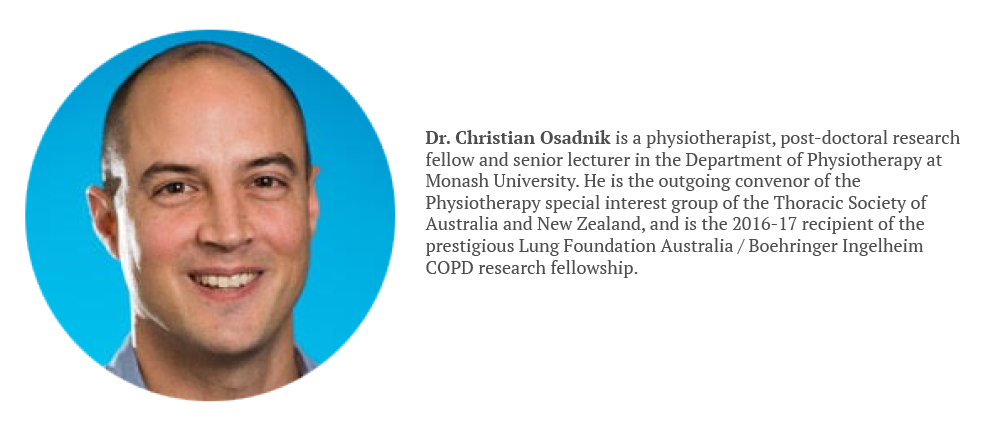
What’s the issue your research is trying to solve?
My research (and topic of my Lung Foundation Australia / Boehringer Ingelheim COPD Fellowship, awarded at the recent TSANZ Annual Scientific Meeting in Perth) seeks to optimise our approaches to rehabilitation for patients who experience acute exacerbations of chronic obstructive pulmonary disease (AECOPDs). It is well known that AECOPDs are important events characterised by significant decreases in exercise capacity, muscle force and physical activity levels. Options exist to manage such deficits after discharge (e.g. pulmonary rehabilitation), yet several barriers limit our ability to link the right patient with the right type of care. Just as COPD is a heterogeneous disease, AECOPDs are also heterogeneous events of differing aetiologies, severity, management and consequences that should be considered when tailoring individualised rehabilitation after hospital discharge. My research aims to look closely at this important disease phase and generate comprehensive data within an Australian-specific healthcare context to inform future interventions seeking to optimise recovery from AECOPD.
What have you discovered so far?
This particular fellowship is due to commence later this year, so I cannot reveal any answers just yet! Formative work in this area from the United Kingdom suggests that distinct patient clusters related to patients’ illness perceptions are identifiable after AECOPD. Such findings, however, have limited applicability to Australia due to its lack of specificity to our local healthcare context. Local data does indicate that differing exacerbation aetiologies affect important clinical outcomes such as hospital length of stay. I hope that a mixed-methods (qualitative and quantitative) approach of comprehensive patient evaluation including consideration of physical and psychological function and different AECOPD phenotypes (defined according to readily available tests and biomarkers) in Australia will lead to the identification of distinct patient clusters that can be targeted more systematically for the right type of tailored rehabilitation. In this respect, I feel the importance of my work is summarised as ‘looking back for the future’.
What’s been your biggest hurdle?
To date, the biggest hurdle has been obtaining dedicated research funding in a highly competitive space to undertake the clinical research topic of my passion. Since undertaking my PhD (conferred in 2013) I have maintained a busy schedule that has included a heavy undergraduate physiotherapy teaching load, convenor and committee responsibilities in organisations such as TSANZ, ERS, ATS and the APA (Australia’s national physiotherapy body), a 1-year ERS post-doc fellowship abroad in Belgium in 2014-15 and the juggle of life with 3 young children (now aged 4 months, 3 years and 5 ½ years)! My family are my number one priority and my kids certainly help me keep things in perspective, but it is challenging to keep up and be competitive in a world of research funding insecurity.
From a project point of view, doing physiotherapy research in patients with AECOPD means it is always challenging to motivate and encourage (I didn’t say nag!) them to get moving and do some exercise tests, particularly when it is necessary after hospital discharge. Data loss can be a killer for a project, so the importance of building rapport and understanding the patient perspective cannot be understated.
How far is your work from impacting patient care?
The nice thing about my research as a physiotherapist working in respiratory medicine is that it is completely about patient care. I have worked hard to place myself in a clinical/research context so I can make an impact upon patient care and improve patient outcomes. The research project is anticipated to be complete within 2 years, at which point the findings will be translatable into clinical care with a minimum of delay. I hope this will lead to further investigations of different approaches to improve recovery from AECOPD.
If you could discover one thing in your research, what would it be? (e.g what’s your holy grail?)
In my ideal world, the holy grail would be quite simple. I wish for people to really value the importance of being physically ‘fit’ and active and appreciate the impact this can have on one’s health. Many people don’t realise that, in COPD, exercise capacity is a better predictor of death than age or lung function! And it is a modifiable factor, which means we can help prevent it. As physiotherapists, we are fortunate to be in a position where we can make a real impact on the lives of patients with COPD, however we have a long way to go to ensure appropriate steps are taken to prevent functional decline from happening in the first place, and ensure seamless, equitable systems operate that link people in need with the most suitable therapies after hospitalisation.
My holy grail therefore starts with recognition and education (of patients and healthcare providers alike) and probably ends with a culture change that sees hospitals become well-oiled machines that prioritise movement over rest. As a realist, I appreciate we are some way off this end game just yet…
If you could take two things to a desert island what would they be?
My family (wife and 3 young kids) – surely that counts as one item…
A soccer ball
What are the two food items you couldn’t live without?
Tea, pasta (actually, just make that Italian food in general!)